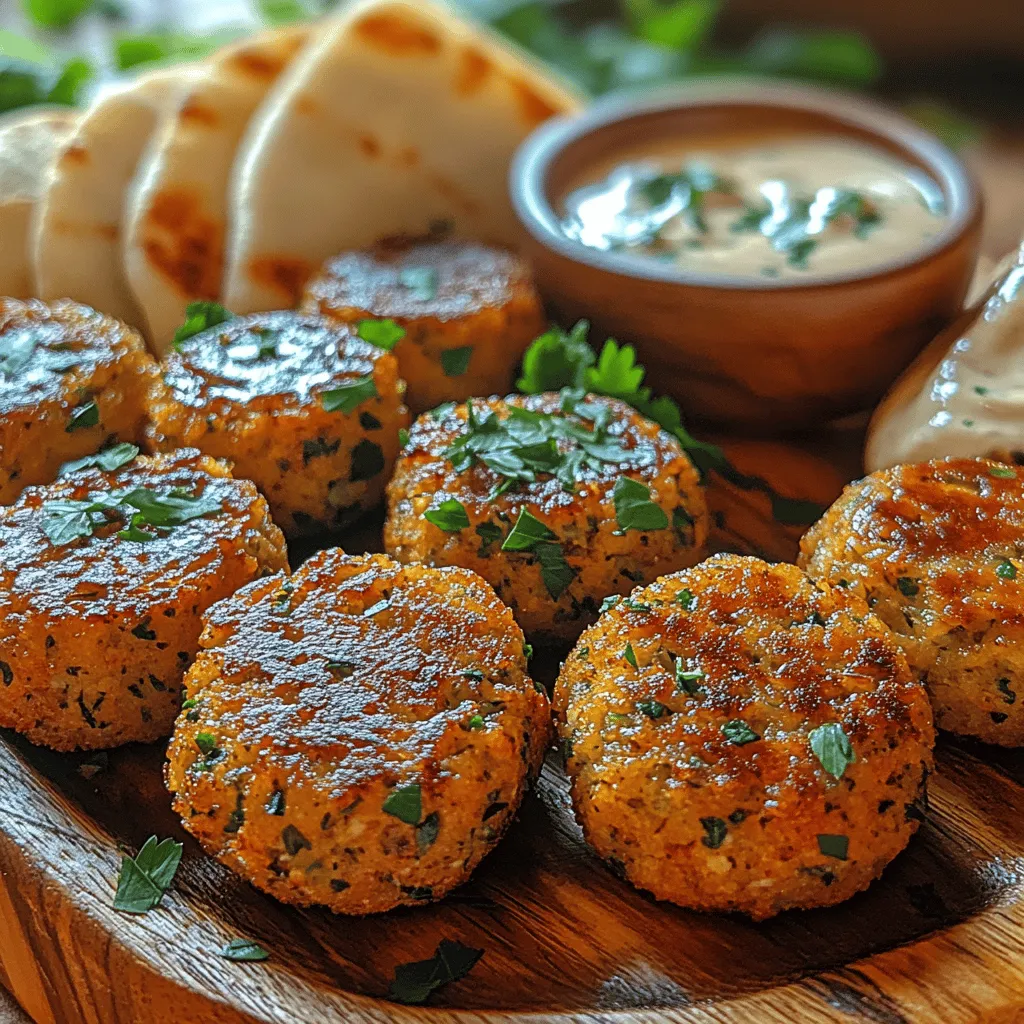Crunchy Baked Falafel Balls Recipe
Introduction
Falafel, a cornerstone of Middle Eastern cuisine, has captured the hearts (and appetites) of food lovers around the world. These delightful balls or patties, typically made from ground chickpeas or fava beans, are seasoned with an array of spices and herbs, then traditionally deep-fried to achieve a crispy texture. However, as health-conscious eating trends become increasingly popular, baked falafel has emerged as a nutritious alternative that doesn’t compromise on flavor or satisfaction.
Baked falafel offers a guilt-free way to enjoy this beloved dish, significantly reducing the calorie count and fat content typically associated with fried versions. By opting for baking, you can indulge in the crispy, crunchy goodness of falafel while embracing a healthier lifestyle. Moreover, the appeal of homemade falafel lies in the ability to control the quality of ingredients, ensuring that each bite bursts with fresh flavors and vital nutrients.
Understanding Falafel: A Cultural and Culinary Exploration
The origins of falafel are somewhat murky, with various claims to its invention across the Middle East. Many believe that falafel has its roots in Egypt, where it was called “ta’ameya,” made primarily from fava beans rather than chickpeas. Over the centuries, falafel spread throughout the region, evolving into many variations that reflect local tastes and ingredients. Today, it is not uncommon to find falafel served as a street food staple in countries such as Lebanon, Israel, and Jordan, often enjoyed in pita bread with fresh vegetables and tahini sauce.
As falafel gained international popularity, it adapted to numerous culinary traditions, resulting in diverse recipes and preparation methods. Some variations incorporate different legumes, while others experiment with spices and herbs. Regardless of the specific ingredients, the fundamentals of falafel remain consistent: a blend of legumes, herbs, and spices, all working harmoniously to create a dish that is as rich in history as it is in flavor.
Benefits of Baked Falafel
Choosing baked falafel over its fried counterpart comes with a plethora of health benefits. One of the most significant advantages is the reduction in calories and fat content, making it a more suitable option for those looking to maintain or lose weight without sacrificing taste. Baked falafel retains the same delightful crunch as fried versions while allowing you to enjoy them with a clearer conscience.
Chickpeas, the primary ingredient in falafel, are not just a delicious source of plant-based protein; they also boast an impressive nutritional profile. Rich in fiber, vitamins, and minerals, chickpeas contribute to improved digestion, enhanced heart health, and sustained energy levels. The incorporation of fresh herbs, like parsley and cilantro, not only elevates the flavor but also adds a wealth of nutrients and antioxidants, further enhancing the overall health benefits of the dish.
Spices play a pivotal role in traditional falafel recipes, with cumin and coriander being staples that provide a warm, aromatic flavor. These spices not only enrich the taste of the falafel but also offer various health benefits, including anti-inflammatory properties and digestive support. The addition of tahini and lemon juice brings a creamy texture and zesty brightness, rounding out the dish beautifully.
Ingredients Breakdown
To make the perfect Crunchy Baked Falafel Balls, selecting high-quality ingredients is crucial. Below is a detailed description of each key component that contributes to the flavor and texture of this dish:
– Chickpeas: The star of the show, chickpeas are essential for creating a hearty and satisfying falafel. For optimal results, it is recommended to use dried chickpeas that have been soaked overnight rather than canned varieties. Soaking dried chickpeas not only enhances their texture but also improves their nutritional profile, making them easier to digest and maximizing their health benefits.
– Fresh Herbs: Fresh parsley and cilantro are indispensable in achieving the vibrant flavor of falafel. Parsley adds a fresh, slightly peppery taste, while cilantro imparts a unique, citrusy note. Both herbs are packed with vitamins and antioxidants, elevating the nutritional value of your falafel while enhancing its overall taste.
– Spices: A combination of cumin and coriander is fundamental to traditional falafel recipes. Cumin lends a warm, earthy flavor that complements the nuttiness of chickpeas, while coriander adds a bright, citrus-like quality. These spices not only enhance the flavor profile but also provide various health benefits, contributing to overall well-being.
– Tahini and Lemon Juice: Tahini, a creamy paste made from ground sesame seeds, adds richness and depth to the falafel. Its nutty flavor pairs wonderfully with the chickpeas and herbs, creating a balanced taste. Lemon juice, on the other hand, brightens the dish and adds acidity, which helps to cut through the richness of the tahini, resulting in a well-rounded flavor.
– Breadcrumbs: While traditional falafel does not typically include breadcrumbs, incorporating them into baked versions can help achieve that coveted crunch. Breadcrumbs act as a binding agent, ensuring that the falafel holds its shape during the baking process while providing an extra layer of texture that enhances the overall eating experience.
With a clear understanding of the ingredients and their roles, you’re ready to embark on your culinary journey to create these delicious, healthy Crunchy Baked Falafel Balls. In the next section, we will delve into the step-by-step process of preparing this delightful dish, ensuring that you achieve the perfect balance of flavors and textures every time.
Olive Oil: Health Benefits and Its Function in Achieving a Crispy Texture
Olive oil is a staple in Mediterranean cuisine and plays a crucial role in the preparation of crunchy baked falafel balls. Not only does it enhance the flavor of the falafel, but it also provides numerous health benefits. Rich in monounsaturated fats, olive oil is known to support heart health, lower bad cholesterol levels, and provide anti-inflammatory properties.
When baking falafel, a light coating of olive oil helps to create that desired crispy texture without the need for frying. The oil facilitates even heat distribution, allowing the falafel to brown beautifully while keeping the insides moist and tender. This balance between health and texture makes olive oil an essential ingredient in our recipe.
Step-by-Step Guide to Making Crunchy Baked Falafel Balls
Soaking the Chickpeas
The first step in creating the perfect baked falafel is soaking the chickpeas. This process is vital for several reasons. First, soaking the chickpeas overnight hydrates them, making them softer and easier to blend. The primary science behind this is osmosis; water moves into the chickpeas, allowing them to swell and soften. Dried chickpeas also contain complex carbohydrates that break down more effectively when soaked, resulting in a better texture in your falafel.
To soak, simply cover the dried chickpeas with plenty of water and allow them to rest overnight (about 8-12 hours). This will ensure they are adequately prepared for the next steps in the recipe.
Preparing the Mixture
Once your chickpeas are soaked, it’s time to prepare the mixture. Drain the soaked chickpeas and rinse them under cold water. Place them in a food processor along with fresh herbs such as parsley and cilantro, garlic cloves, onion, and spices like cumin and coriander.
A crucial tip for achieving the perfect falafel texture is to pulse the mixture—not blend it. Pulsing allows the ingredients to combine while retaining some texture, which is key to avoiding a mushy end product. Aim for a coarse mixture that holds together when pressed. If your mixture feels too dry, you can add a tablespoon of water; however, be cautious not to overdo it, as you want to maintain that ideal consistency.
Mixing in Wet Ingredients
Next, it’s time to enhance the flavor profile with wet ingredients. Add tahini—a sesame paste that contributes a nutty flavor—and freshly squeezed lemon juice to the mixture. The tahini not only adds richness but also helps bind the ingredients together due to its creamy consistency. The acidity from the lemon juice brightens the overall flavor and balances the earthiness of the chickpeas.
Blend the mixture for just a few seconds until combined. Taste the mixture and adjust seasoning if necessary, adding more salt or spices according to your preference.
Chilling the Mixture
Before shaping your falafel balls, it’s essential to chill the mixture. Cover it with plastic wrap or transfer it to an airtight container and refrigerate for at least 30 minutes. Chilling is crucial for binding, as it firms up the mixture and makes it easier to handle. Cold mixtures hold their shape better when baking, thus preventing your falafel balls from falling apart.
Shaping the Falafel
Now that your mixture is chilled, it’s time to shape the falafel. Use a scoop or your hands to form uniform balls or patties, about 1.5 inches in diameter. This ensures even cooking and a consistent texture. For added crunch, lightly roll each ball in breadcrumbs before placing them on a baking sheet. This step is optional but recommended, as breadcrumbs can enhance the crispy texture of your falafel.
Ensure you leave space between the falafel on the baking sheet to allow for even cooking. A parchment-lined baking sheet can help prevent sticking and make cleanup easier.
Baking Process
Preheat your oven to 400°F (200°C). Once the oven is ready, drizzle a little olive oil over the falafel balls to promote crispiness while baking. Bake for about 25 to 30 minutes, flipping them halfway through to achieve an even golden-brown crust. Keep an eye on them towards the end to ensure they don’t over-brown. The result should be beautifully crispy on the outside while remaining tender and flavorful on the inside.
Serving Suggestions
Baked falafel can be enjoyed in a variety of ways, making them a versatile addition to any meal.
Creative Ways to Serve Baked Falafel
1. Traditional Accompaniments: Serve your falafel in warm pita bread with sliced tomatoes, cucumbers, and lettuce. Add a dollop of tahini sauce or your favorite dressing for extra flavor.
2. Dips: Enhance your falafel experience with delicious dips. Tahini sauce perfectly complements the nutty flavors of the falafel, while tzatziki offers a refreshing yogurt-based contrast. For those who enjoy a kick, spicy harissa can add a delightful heat to the dish.
3. Salad Bowls: Elevate your salads or grain bowls by adding falafel. Combine them with mixed greens, roasted vegetables, quinoa, or couscous for a satisfying and nutritious meal. Drizzling with a lemon-tahini dressing can tie all the flavors together beautifully.
Storage and Reheating Tips
Best Practices for Storing Leftover Falafel
If you have leftover falafel, proper storage is key to maintaining their texture. Allow them to cool completely before transferring to an airtight container. Refrigerate for up to 3-4 days.
For longer storage, freeze the falafel balls. Place them in a single layer on a baking sheet and freeze until solid. Once frozen, transfer them to a freezer-safe bag or container. Frozen falafel can last for up to three months. When you’re ready to enjoy them, there’s no need to thaw; simply bake them directly from the freezer.
How to Reheat Falafel to Maintain Crunchiness
To reheat falafel while preserving their crispy texture, place them on a baking sheet and preheat your oven to 375°F (190°C). Bake for about 10-15 minutes, or until heated through and crispy on the outside. You can also use an air fryer to achieve a similar result, cooking at the same temperature for 5-7 minutes. Avoid using the microwave, as it can make the falafel soggy.
Conclusion
The joy of making and enjoying homemade baked falafel is unparalleled. With their crunchy exterior and tender inside, these falafel balls can be a delightful addition to any meal. They not only provide a hearty and satisfying option for those seeking plant-based dishes but also allow for creativity in serving styles.
Feel free to experiment with various flavors, herbs, or spices in the mixture, and explore different serving styles to suit your taste. Preparing a healthy, delicious meal from scratch can be immensely satisfying, and these baked falafel balls are a testament to that. Whether enjoyed alone, in a wrap, or as part of a colorful salad bowl, your homemade falafel will surely impress family and friends alike. Enjoy the process and the delightful flavors that come with it!


